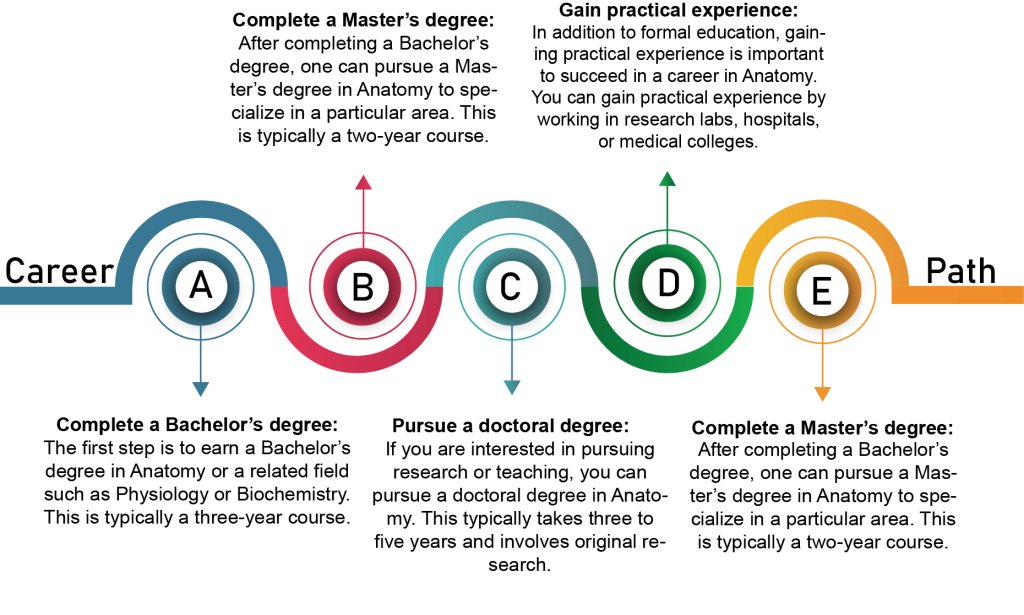Anatomy is the scientific study of the structure of living organisms. This includes human beings, animals, and plants. In the context of a career in India, anatomy is primarily associated with human anatomy, which involves the study of the structure and function of the human body. Anatomy is a branch of medical science and plays a crucial role in medical education and research.
Work description
A person with a career in Anatomy may work in a variety of settings, such as research institutions, medical schools, hospitals, and forensic labs. Their work may involve:
- Conducting research studies on the structure and function of human organs, tissues, and cells.
- Analyzing and interpreting data obtained from medical imaging techniques, such as CT scans, MRI scans, and X-rays.
- Preparing anatomical specimens for use in medical education and research, such as dissection and preservation of cadavers.
- Collaborating with other medical professionals, such as surgeons and radiologists, to improve patient care.
- Developing and testing new medical technologies and treatments.
- Conducting forensic analyses to determine the cause of death or identify individuals.
Overall, the work of an anatomist is focused on understanding the human body’s structure and function, contributing to advancements in medical research, and educating the next generation of healthcare professionals.
High Demand
Opportunity to contribute to medical research and advancements.
Lucrative salaries
Opportunities to work in diverse fields like forensic science, medical illustration, and medical education.
Opportunities for innovation
High demand for anatomists in medical schools, hospitals, and research institutions.
Versatility
Potential for career growth and advancement in academia and research.
Flexibility
Chance to work with advanced technology and equipment, such as CT scanners and MRI machines.
Job satisfaction
Competitive salary and benefits packages.
High stress
High level of education and training required, including obtaining a doctoral degree.
Long hours
Competitive job market and limited job openings in some geographic areas.
Competitive field
Long hours and irregular schedules in research and academic settings.
Constant learning
Exposure to biological specimens and chemicals that may pose health risks.
Isolation
High stress levels and pressure to perform in academic and research environments.
Eye strain and other physical health issues
Limited opportunities for interaction with patients and direct patient care.
The cost of pursuing a career in Anatomy in India can vary depending on several factors such as the type of institution, the course duration, and the location of the institution. Here are some general estimates:
Bachelor’s degree: The cost of a Bachelor’s degree in Anatomy can range from INR 20,000 to INR 2,00,000 per year, depending on the institution.
Master’s degree: The cost of a Master’s degree in Anatomy can range from INR 30,000 to INR 3,00,000 per year, depending on the institution.
Doctoral degree: The cost of a Doctoral degree in Anatomy can range from INR 50,000 to INR 5,00,000 per year, depending on the institution.
Apart from tuition fees, there may be additional expenses such as accommodation, food, textbooks, and laboratory fees. The cost of living can vary depending on the location of the institution.
The earning potential of someone with a career in Anatomy in India can vary depending on several factors such as education level, experience, and job sector. However, the average salary can range from 4 lakh to 13 lakh per year. =The entry-level salary can range from 4-5 lakh per year which can go up to 10-13 lakh per year with experience. The salary also depends upon several factors like job location, type of job, etc.
Strong attention to detail.
Good spatial reasoning and visualization skills.
Creativity and innovation.
Ability to work well in a team.
Good communication skills for explaining complex ideas to others.
Passion for technology and eagerness to learn.
Strong foundation in math and science.
Difficulty with long periods of standing or sitting still during dissections or other procedures.
Poor hand-eye coordination or manual dexterity.
Strong aversion to blood or other bodily fluids.
Difficulty with memorization or recalling complex anatomical structures.
Limited ability to work in a team or collaborate with others.
Lack of attention to detail or focus.
Limited interest in biology or human anatomy.
Work-life balance
The field of Anatomy is a highly specialized and demanding career path that requires a great deal of dedication and commitment. As with any profession, it is important to maintain a healthy work-life balance in order to achieve success and maintain personal wellbeing.
Anatomy professionals typically work in academic settings, research institutions, or medical facilities, and their work may involve research, teaching, or clinical applications. They may work long hours, including evenings and weekends, in order to complete research projects or meet deadlines for academic publications. In addition, they may be required to attend conferences or other professional events that require travel.
The Work-Life Balance of a Computer Engineer can vary depending on various factors such as job role, industry, and company culture.
However, in general, computer engineering can be a Demanding Field with long hours and tight deadlines, which may impact work-life balance. Some computer engineers may need to work Overtime, Weekends, or be on call for emergencies.
However, many companies also offer Flexible Work Hours, Work From Home Options, and other benefits to promote work-life balance. To maintain a healthy work-life balance, computer engineers can prioritize Time Management, Set Boundaries, and Make Time For Hobbies and other activities outside of work.

A career in Anatomy can provide a sense of fulfillment and accomplishment by contributing to scientific advancements and improving medical treatments.
Anatomy professionals may have opportunities to collaborate with other experts in the field and engage in cutting-edge research.
Anatomy careers can be financially rewarding, with competitive salaries and opportunities for advancement.
The demand for skilled Anatomy professionals is expected to grow, creating potential job security and career stability.
However, the field can be competitive and demanding, requiring a significant amount of time, effort, and dedication.
Anatomy professionals may face challenges with work-life balance due to long hours and demanding workloads, which can impact personal relationships and wellbeing.
Gross Anatomy
This specialization focuses on the study of the structure and organization of the human body at the macroscopic level, including dissection and examination of human cadavers.
Histology
This specialization focuses on the study of the microscopic structure of tissues and organs, including the use of advanced imaging techniques such as electron microscopy.
Embryology
This specialization focuses on the study of the development of the human body from conception to birth, including the formation and differentiation of tissues and organs.
Neuroanatomy
This specialization focuses on the study of the structure and organization of the nervous system, including the brain, spinal cord, and peripheral nerves.
Radiological Anatomy
This specialization focuses on the use of medical imaging techniques such as CT scans, MRI, and ultrasound to study the structure and function of the human body.
Conclusion:
Anatomy is a fascinating field that offers a range of career options in India. Whether you are interested in teaching, research, or forensic science, there are opportunities to make a meaningful contribution to the study of the human body. While there are some challenges to pursuing a career in anatomy, the rewards can be significant for those who are passionate about the subject. If you are considering a career in anatomy, it is essential to research the various options available and determine which path is right for you.




